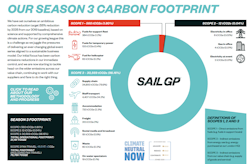Going low-carbon with our trips

New Zealand rugby team and France SailGP Team choosing low-carbon mobility
The "Quentin Express" challenge
Last week took place the “Quentin Express“: Energy Observer and France SailGP Team embarked on a journey from Barcelona to Saint Tropez, using only low-carbon mobility. This was the occasion to highlight the different solutions that can contribute to limit the carbon footprint of the transport sector and draw attention to the importance of indirect greenhouse gases emissions in the event industry.

"Quentin Express"
The event industry as a whole can contribute to up to 10% of the world’s greenhouse gas emissions! This includes everything from the materials we use, the energy we consume, and the transportation needed for attendees to get to the event venue, resulting in a substantial carbon footprint. But how can we estimate the amplitude of these emissions, what should be included in the balance, how can their impact be limited? Find out more with Beatrice Cordiano, onboard scientist on Energy Observer.
Carbon accounting: scope 3
To tackle emissions, it’s important to understand and measure where they’re originated from in the first place. You have probably all heard about direct and indirect emissions in carbon accounting, but what about Scope 1, 2 and 3?
These three scopes are a way to categorize a company’s emissions. Essentially, scope 1 is what we call ‘direct’ emissions, namely all those that stem from operating machinery, manufacturing products, heating buildings, running computers etc. Scope 2 are ‘indirect’ emissions - meaning they are not produced by the company itself - generated by the source used for the consumed energy. And, eventually, scope 3 are all the indirect emissions associated to suppliers or customers somehow related to the company. And guess what, the latter are by far the most important ones - accounting for more than 70% of a business’ carbon footprint - and the ones an organisation has less control on.
“With the Impact League, the podium for the planet, all teams play along the rules. Beyond the sustainable approach, the competitive aspect encourages the teams to find solutions or to do things differently.”
The events industry is no exception. When it comes to live events, the scope 3 pool gathers all the emissions from the production and transportation of goods and services, including food, merchandise or stage materials, from the accommodations used by the attendees and the event staff and from… transportation.
We must rethink the way we travel
Take the 2022-2023 SailGP championship: their report shows that the total carbon footprint of the event stood at 79 786 tCO2e. Scope 3 represented 98,16% of all these emissions, staff transport was 14,2% of scope 3, meaning 4 407 tCO2e. That’s a huge amount which becomes tiny compared to the 48 645 tCO2e released for fans travel. To wrap up, transportation made up to more than 65% of all the event carbon footprint. This is equivalent to 7.3 million meat-based meals or to 2.3 million jeans or to what a single passenger emits on more than 53 000 one way-trips from Paris to New York by plane.

France SailGP Team racing in Saint Tropez
Here’s why environmental sustainability is something we should apply to event planning, companies’ travel strategies and, to a further extent, to the global transport sector. Events transportation is in fact just a thin slice of the cake.

SailGP's season 3 carbon footprint
Transport, more generally, is a pillar of modern societies: it connects people, cities, nations, continents, and cultures, facilitates the global exchange of goods, ensures access to essential public services like education and healthcare, stimulates economic growth bridging remote regions. We cannot do without it, yet its environmental impact is anything but sustainable. Still highly dependent on internal combustion engines running on fossil fuels, the entire transport industry accounts for a third of CO2 emissions from end-use sectors. We must rethink the way we travel, limiting our trips and shifting to low-carbon solutions when possible.

Victorien Erussard and Quentin Delapierre aboard a Toyota Mirai
To gain a better understanding of the available solutions and the impact they have, it's essential to compare the carbon emissions of different transportation modes. A way to do it is to assess the amount of CO2 emitted per kilometre and per passenger. It is not an easy task since many factors come into play: the vehicle’s model, the country where it is manufactured, its longevity, the speed at which it runs, the traffic conditions, the country's energy mix in the case of electric vehicles and many more.
On a scale from walk to plane
With a carbon footprint of about 230 gCO2/km per passenger, there's no denying the environmental impact of aircraft is the worst possible. Second in the ranking of the most polluting modes of transport is the car. With a carbon footprint ranging from 190 to 218 gCO2/km per person whether it is a gasoline or a diesel one, it is the most widely used mode of transport.

"Quentin Express" choosing bikes
Cars can be “cleaner”, they can be electric. Today EVs are the best option of private transport: unlike their thermal counterparts they emit way less carbon emissions, even in regions with a predominantly high-carbon electricity mix. Although it's true that electric cars may generate more emissions during their manufacturing phase compared to combustion engine vehicles, this excess CO2e is more than offset during their operational life.
“A hydrogen vehicle complements a battery-powered vehicle. The most important thing about these vehicles is to preserve energy! Thus, we must adopt eco-driving!”
In France, for instance, an electric car emits 2 to 3 times less than a combustion engine vehicle and the greener is the country’s electricity mix, the bigger the gain. As technology develops, the landscape of sustainable transportation is evolving, with hydrogen cars (FCEVs) gaining momentum.

"Quentin Express" choosing a Toyota Mirai
Similar to EVs, FCEVs offer a competitive carbon footprint: they can emit up to 75% less than diesel cars when hydrogen is produced by water electrolysis powered by French electricity. While it can be challenging to compare EVs and FCEVs carbon footprints, one thing is clear: hydrogen cars have greater autonomies and can be “recharged” quicker than standard EV, the advantage is there and it is undeniable.

Empreinte carbone moyenne d'une voiture vendue en 2020 en fonction de son kilométrage (gCO2e/km)
Moving along the spectrum, trains are the next environmentally responsible option and their impact varies depending on the category: TGV emits a mere 2,4 gCO2/km, Intercité 5,9 g and TER 29,6 g. Taking the train over a plane or a car results in a significant reduction in terms of pollution.

"Quentin Express" choosing the train
Finally, at the bottom of the scale of low-carbon transports are the old but gold bicycles. Despite, like every other industrial product, their fabrication comes with a little carbon footprint, bicycles produce absolutely no greenhouse gases during use, which makes them the most efficient and sustainable solution for short urban journeys.

"Quentin Express" choosing bikes
Transitioning to a more environmentally friendly mode of transportation is becoming increasingly vital and every choice we make - whether it's choosing an electric vehicle or opting for public transport or carpooling - contributes to a more sustainable future. Nevertheless, do not forget that one of the best decisions you can make as a personal initiative to combat climate change is to take up cycling or walking. So, walk, bike, and if you cannot, choose wisely !

"Quentin Express" finish line
To go further
- Critical minerals, heroes of the energy transition - Energy Observer
- 5 Tips to Reduce the Carbon Footprint of your Events - Greenly
- How clean are electric cars? - Transport & Environment
- Mon impact transport - Datagir
- Factcheck: How electric vehicles help to tackle climate change - Carbon brief